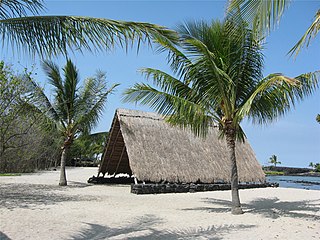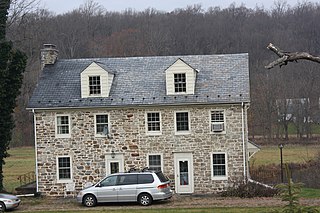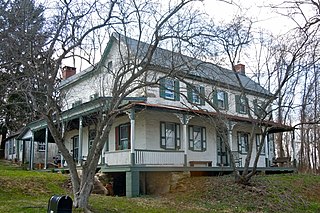
Kaloko-Honokōhau National Historical Park is a United States National Historical Park located in the Kona District on the Big island of Hawaiʻi in the U.S. state of Hawaiʻi. It includes the National Historic Landmarked archaeological site known as the Honokōhau Settlement. The park was established on November 10, 1978, for the preservation, protection and interpretation of traditional native Hawaiian activities and culture.

Backbone State Park is Iowa's oldest state park, dedicated in 1919. Located in the valley of the Maquoketa River, it is approximately three miles (5 km) south of Strawberry Point in Delaware County. It is named for a narrow and steep ridge of bedrock carved by a loop of the Maquoketa River originally known as the Devil's Backbone. The initial 1,200 acres (490 ha) were donated by E.M. Carr of Lamont, Iowa. Backbone Lake Dam, a relatively low dam built by the Civilian Conservation Corps (CCC) in the 1930s, created Backbone Lake. The CCC constructed a majority of trails and buildings which make up the park.

Cold Spring Farm, also known as Peter and Louisa Morton Farmstead, is a historic farmstead located in Todd Township, Fulton County, Pennsylvania. The property includes three contributing buildings: the main house (1900), sandstone spring house with a Queen Anne style second floor addition, and a sandstone slaughterhouse. The house is a two-story, five bay, brick structure with a cross gable roof and Palladian window. It features a wraparound porch with wide, overhanging eaves.

James Mason House and Farm is a historic home located at Hedgesville, Berkeley County, West Virginia. The two-story stone house was built about 1809, and is a four-bay limestone building with a gable roof measuring 24 feet wide by 22 feet deep. A two-story, concrete block residential addition was completed about 1900. Also on the property is a bank barn and corn crib.

Maidstone Manor Farm, also known as William R. Leigh House, is a national historic district located near Hedgesville, Berkeley County, West Virginia. It encompasses a historic farm with three contributing buildings and one contributing site, the site of a slave cabin. The plantation house is a two-story, square brick dwelling with a slate covered pyramidal roof. It is three bays wide and two bays deep and features a one bay entrance portico supported by paired Doric order columns. Also on the property are a barn and brick smokehouse. It was the birthplace of noted artist William Robinson Leigh (1866-1955), father of William Colston Leigh, Sr. (1901-1992).

McCalls Ferry Farm, also known as the Robert and Matthew McCall Farm, Atkins-Trout Farm, and Kilgore Farm, is a historic farm and national historic district located at Lower Chanceford Township in York County, Pennsylvania. The district includes six contributing buildings and two contributing sites. The buildings are the farmhouse, Sweitzer barn, frame corn barn, tobacco barn, milk house, and chicken house. The farmhouse is a banked Pennsylvania German vernacular dwelling built of stone and coated in stucco. It measures 40 feet wide and 30 feet deep, and has a slate covered gable roof. The sites are the stone foundation of a scale house and the ruins of a small dwelling.

Sinking Springs Farms is a historic farm and national historic district located at Manchester Township in York County, Pennsylvania. The district includes 32 contributing buildings, 2 contributing sites, and 17 contributing structures. The district includes the Manor House Demesne, four farmsteads, and a Radio Broadcast Complex. The manor house dates to 1900, and is a 2 1⁄2-story, Colonial Revival-style dwelling modified in 1936–1941. Farmstead #1 includes the earliest buildings, dated to about 1841. Farmstead #2 includes a Shingle Style dwelling designed by architect John A. Dempwolf and built about 1893. Farmstead #3 has a 3 1⁄2-story, banked Pennsylvania German dwelling built about 1845. Farmstead #4 has a 3 1⁄2-story, banked Georgian-plan dwelling built about 1845. The Radio Broadcast Complex includes a 2 1⁄2-story, brick Colonial Revival-style office building and four radio towers, and used as a radio station from the 1940s until 1990.

Corker Hill is a historic home and farm complex located at Greene Township in Franklin County, Pennsylvania. The manor house was built between 1810 and 1820, and is a two-story, seven bay, brick dwelling on a limestone foundation in the Federal style. The facade was modified about 1905, to add Colonial Revival style elements, such as a cupola and wraparound porch. Also on the property are the contributing large stone and frame Pennsylvania bank barn, stone vaulted root cellar, frame shed / chicken coop, frame carriage house / garage, small stone furnace building, wagon shed / corn crib, and frame tenant house.

Brotherton Farm, also known as the Brotherton-McKenzie Farm, is a historic home and farm complex located at Guilford Township in Franklin County, Pennsylvania. The house was built about 1820, and is a two-story, five bay, "L"-shaped limestone dwelling in the Federal style. It has a two-story, four-bay rear ell. Also on the property are the contributing 1 1/2-story stone spring house, frame wash house, and frame bank barn.

Hays Bridge Historic District is a national historic district located in Montgomery Township, Franklin County, Pennsylvania. The district includes two contributing buildings and two contributing structures. The buildings are a three-story, five bay limestone house and bank barn, dated to the early-19th century. The structures are an early 19th-century stone double arch bridge and a Burr Truss covered bridge dated to 1883. The covered bridge, known as Ped Bridge or Witherspoon Bridge, is 87 feet long and 14 feet wide, with a corrugated metal roof. It is the only remaining covered bridge in Franklin County.

Windom Mill Farm is a historic farm and national historic district located at Manor Township, Lancaster County, Pennsylvania. The district includes 12 contributing buildings and 1 contributing site. They are the main farmhouse, a stone end Pennsylvania bank barn, a mill (1810), the miller's house, a former tavern now a dwelling, two tobacco sheds, a frame corn barn, a garage, a milk house, a pigpen, and a former carriage house. The contributing site is the remains of the family cemetery. The farmhouse was built about 1780, and is a 2 1/2-story, five bay by two bay, limestone dwelling with a full-width front porch. It is in the Federal style.

Philip Erpff House is a historic home located at Schaefferstown, in Heidelberg Township, Lebanon County, Pennsylvania. It was built about 1750, and is a 2 1/2-story, limestone residence with a gable roof. It is five bays wide and measures 36 feet, 7 inches, by 26 feet, 6 inches. It features large limestone quoins and a limestone chimney and is in the vernacular Germanic tradition. Also on the property are a contributing limestone wash house, limestone spring house, and the "Arch." The Arch is an underground cold storage area. It has a vaulted ceiling and two niches on the back wall.

John Immel House is a historic home located at Jackson Township, Lebanon County, Pennsylvania. It was built in 1814, and is a 2 1/2-story, "L"-shaped limestone residence, four bays wide and four bays deep. It has a 32 feet by 32 feet main section, with an 18 feet by 18 feet rear extension. The central front bay features a full pediment. Also on the property is a contributing wooden shed.

Rhoads-Lorah House and Barn, also known as "Five Springs Farm," is a historic home and barn located in Amity Township, Berks County, Pennsylvania. It was built about 1830, and is a 2 1/2-story, five bay, limestone dwelling in the Georgian style. It measures 42 feet by 20 feet. It is attached to an earlier two-story, 17 feet by 17 feet, stone dwelling, making a "T"-shape. The stone barn was also built about 1830, and measures 66 feet by 41 feet. Also on the property are a contributing springhouse, drive-through corn crib, and machinery shed.

Jacob Funk House and Barn is a historic home located at Springfield Township, Bucks County, Pennsylvania. The house consists of three sections; the oldest built about 1792. It is a 2 1/2-story, stone dwelling measuring 40 feet wide and 28 feet deep and originally reflective of the Georgian style. The oldest section is a two-story, two bay, stone structure two rooms deep. About 1855, a two-story, three-bay extension was added to the east gable. A kitchen and bath addition was built about 1930. The house was remodeled in the Colonial Revival style between about 1945 and 1955, at which time a one-story addition and deck were added to the rear of the house. Also on the property are a contributing stone bank barn and stone spring house.

Squire Cheyney Farm is a historic farm and national historic district located in Thornbury Township, Chester County, Pennsylvania. The district encompasses two contributing buildings, three contributing sites, one contributing structure, and contributing object. They are the farmhouse, barn, ruins of a granary, remains of an ice house, a spring house (1799), stone retaining wall, and family cemetery. The house was built in four periods, with the oldest dated to about 1797. The oldest section is a 2 1/s-story, three bay, stuccoed stone structure with a gable roof. The additions were built about 1815, about 1830, and about 1850, making it a seven-bay-wide dwelling. It is "L"-shaped and has a slate gable roof. During the American Revolution, Thomas "Squire" Cheyney [II] informed General George Washington during the Battle of Brandywine that the British were flanking him to the north. He was later appointed to the Pennsylvania Ratifying Convention to ratify the United States Constitution. The site is now a township park known as Squire Cheyney Farm Park.

Springton Manor Farm is a historic farm and national historic district located in Wallace Township, Chester County, Pennsylvania. The farm has 14 contributing buildings, 1 contributing site, and 5 contributing structures. They include the main house, a cistern, tool shed, privy, spring and milk house, carriage house, small barn, corn crib, bank barn, stone lean-to, the ruins of a stone spring house, and hydraulic dams. The main house is in three sections; the earliest dates about 1836, with additions and modifications made in 1887 and 1912. It is a 2 1/2-story, seven bay by two bay, stuccoed stone dwelling with Georgian and Queen Anne style design details. Originally built by Joseph Muckleduff in the early 1700s. Upon Joseph's death 9 Sep 1750, Springton Manor was left to his brother Samuel Muckleduff. [Chester Co PA Wills & Mention in Wills 1713 - 1825]. It was the home of Congressman Abraham Robinson McIlvaine (1804-1863). The property is administered as a park and agricultural history museum by Chester County.

Joseph and Esther Phillips Plantation, also known as The Old Ritter Farm, is a historic home and farm located in West Fallowfield Township, Chester County, Pennsylvania, USA. The plantation was established in 1813 when the house was built. The house is a 2½-story, five bay, stuccoed limestone structure. It is built in the Georgian "I"-plan. It has a Gothic Revival style porch added in the 1850s. Other contributing buildings are two stone and frame bank barns, a stone octagonal smokehouse, a frame carriage house and workshop, and a two-story, stone spring house.

John K. Beery Farm is a historic home and farm complex located near Edom, Virginia, United States. The main house dates to 1838, and consists of a two-story, five bay, central-hall plan, main section with a one-story, three bay east wing. The main section measures 50 feet wide and 18 feet deep and features a long one-story, late-19th century porch. Also on the property are a number of contributing outbuildings including a stone bank barn, loom house, spring house, wash house / kitchen, granary, sheds, and an outhouse. The meeting room in the east wing of the house served a large congregation of Mennonites for a number of years. John K. Berry was a descendant of Swiss settlers in Pennsylvania.

Lacey-Keosauqua State Park is located southwest of Keosauqua, Iowa, United States. The park located along the Des Moines River in Van Buren County, it was dedicated in 1921. It is the largest state park in size in Iowa. In 1990 three areas were named nationally recognized historic districts and listed on the National Register of Historic Places.
























